注:机翻,未校对。
What Are Teletypes, and Why Were They Used with Computers?
什么是电传打字机,为什么它们与计算机一起使用?
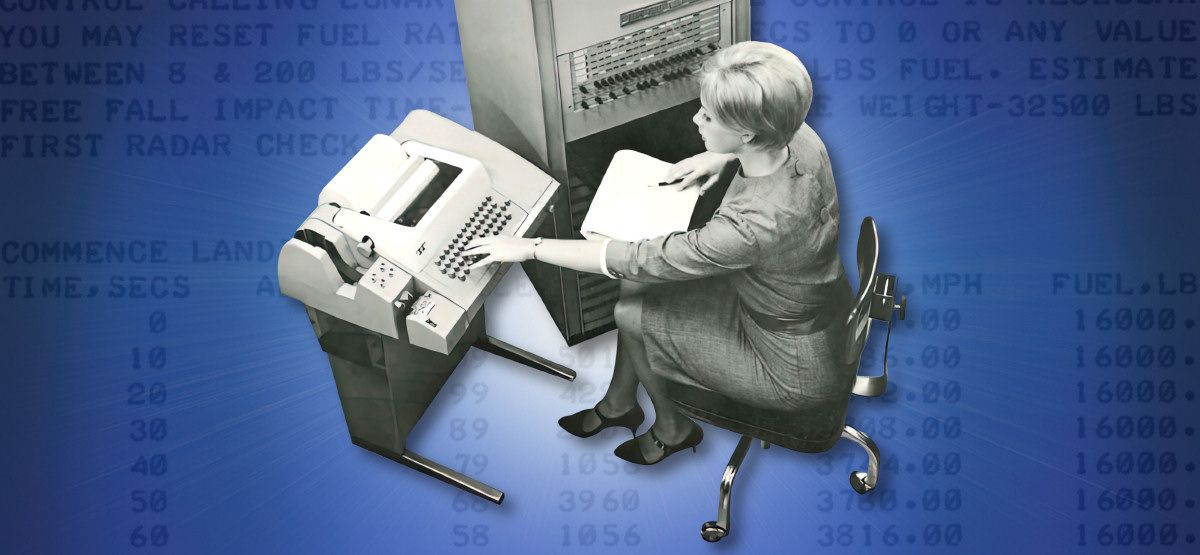
For a few decades, many computer system operators used devices called teletypes to interact with computers using a typewriter-style keyboard and output printed on spools of paper. Here’s why.
几十年来,许多计算机系统操作员使用一种叫做电传打字机的设备,通过打字机式的键盘和打印在纸卷上的输出与计算机交互,这就是原因所在。
What’s a Teletype? 什么是电传打字机?
A teletype (or more precisely, a teleprinter) is a communications device that allows operators to send and receive text-based messages using a typewriter-style keyboard and printed paper output.
电传打字机(或更准确地说,电传打印机)是一种通信设备,允许操作员使用打字机式键盘和打印纸输出发送和接收基于文本的消息。
The term “teletype” originated as a trademarked term for a brand of teleprinters created by the Teletype Corporation in 1928. Teletype Corporation’s products became so ubiquitous that “teletype” evolved into a generic term synonymous with “teleprinter,” especially in the field of computers.
“电传打字机” 这个术语源于 1928 年由 Teletype Corporation 创造的一种电传打字机的商标。Teletype Corporation 的产品变得如此普遍,以至于 “电传打字机” 演变成一个通用术语,与 “电传打字机” 同义,特别是在计算机领域。
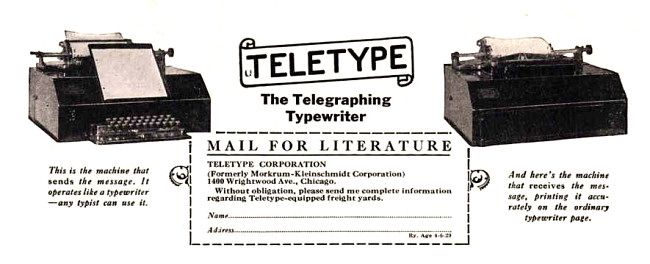 Teletype Corporation
Teletype Corporation
To understand the basic principle behind teleprinters, imagine two electric typewriters linked together by wires (or a wireless radio link). Whatever you type on one typewriter gets automatically printed out on the other. Now imagine that these two typewriters can be any distance away thanks to wired networks or radio transmissions, and you’ll understand what a revolution in communications they represented in the early 20th century.
要理解电传打字机背后的基本原理,可以想象两台通过电线(或无线电链接)连接在一起的电动打字机。你在其中一台打字机上输入的任何内容都会自动打印在另一台上。现在想象这两台打字机可以通过有线网络或无线电传输相距任意距离,你就能理解它们在 20 世纪初所代表的通信革命。
Primitive teleprinters first emerged as early as the 1840s and provided an advantage over Morse code operations with a telegraph key, because a teleprinter’s output was instantly human-readable without the need for special training. In the early 1900s, teleprinters became more reliable and easier to use, adding a familiar QWERTY keyboard and the ability to record messages on paper tape for repeated re-transmission. A single teletype operator familiar with operating a typewriter could replace two trained telegraph operators, and news could be dispatched instantly across the world to receiving teletype units that didn’t need to have keyboards.
原始的电传打字机早在 1840 年代就出现了,提供了比使用电报键的摩尔斯电码操作更大的优势,因为电传打字机的输出可以立即被人类读取,而无需特殊培训。在 1900 年代初期,电传打字机变得更加可靠和易于使用,增加了熟悉的 QWERTY 键盘以及将消息记录在纸带上的能力,以便重复传输。一个熟悉操作打字机的电传打字员可以代替两个训练有素的电报员,新闻可以立即发送到世界各地的接收电传打字机的单位,而后者不需要有键盘。
Why Did People Use Teletypes with Computers? 为什么人们在计算机上使用电传打字机?
To imagine why a teletype would be useful with a computer, recall those two remotely linked typewriters from the last example and replace one of them with an interactive computer system. Instead of communicating with a remote teleprinter, you’re sending and receiving human-readable text to and from a computer. The computer could be in the same room, in another part of a building, or even halfway across the world when linked by a telephone network.
要想象电传打字机在计算机中为何有用,可以回想一下上一个例子中的两台远程链接的打字机,并将其中一台替换为一个交互式计算机系统。你不是与远程电传打字机进行通信,而是向计算机发送和接收人类可读的文本。计算机可以位于同一个房间、建筑物的另一部分,甚至通过电话网络连接到世界另一端。
Many early large computer systems (especially those sold by IBM) were batch operated, which meant that a program would be typed onto punched cards, the punched cards would be fed into the machine with other programs (in a batch), and then the results would be written onto another stack of punched cards. The output stack would then be fed into a tabulating machine or a printer that would print the results in human-readable form.
许多早期的大型计算机系统(特别是 IBM 销售的那些)都是批量操作的,这意味着程序会被输入到打孔卡上,打孔卡会与其他程序一起(以批处理形式)送入机器,然后结果会被写入另一叠打孔卡中。输出叠随后会被送入一个制表机或打印机,以人类可读的形式打印结果。
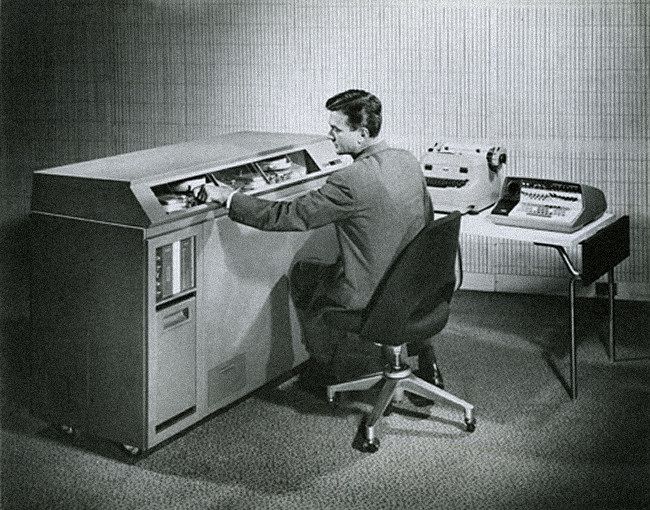 IBM
IBM
Alongside batch computing in the mid-1950s, engineers began to experiment with interactive computing, where a computer operator could provide input and get results back in almost real-time in a sort of interactive “conversation” with the machine. Many of these computers, such as the Bendix G-15 (1956) and the IBM 610 (1954) used modified electric typewriters as either input or output devices, but not necessarily commercial teleprinters.
除了 1950 年代中期的批处理计算外,工程师们还开始尝试交互式计算,计算机操作员可以在与机器的交互式 “对话” 中提供输入并几乎实时地获得结果。其中许多计算机,如 Bendix G-15(1956 年)和 IBM 610(1954 年)使用改进的电动打字机作为输入或输出设备,但不一定是商业电传打印机。
The invention of time-sharing in 1959 allowed multiple users to share an interactive computer system at the same time, making low-cost, single-personal terminals like teletypes desirable for computer use. As time-sharing became more common in the 1960s, organizations with mainframe computers began to buy off-the-shelf commercial teletype machines to use as terminals more frequently.
1959 年分时共享的发明使多个用户能够同时共享一个交互式计算机系统,从而使得像电传打字机等低成本、单一个人终端成为计算机使用的理想之选。随着分时共享在 1960 年代变得更加普遍,拥有大型计算机的组织开始更频繁地购买现成的商业电传打字机作为终端使用。
Enter the Teletype Model 33 输入电传打字机型号 33
One of the biggest reasons that the term “teletype” became so strongly associated with computing was the Teletype Corporation Model 33 (sometimes called the “ASR 33”), which was first introduced in 1963. Unlike most other teleprinters at the time, the Model 33 could understand the ASCII standard, which the American National Standards Institute had recently developed as a standard code for electronic devices and computers. ASCII provided a common framework for how computers stored and transmitted letters and numbers, allowing many different brands of computers to easily communicate with each other.
“电传打字机” 这个术语与计算机如此紧密相关的一个主要原因是 Teletype Corporation Model 33(有时称为 “ASR 33”),该设备于 1963 年首次推出。与当时大多数其他电传打字机不同,Model 33 可以理解最近由美国国家标准协会开发的 ASCII 标准,这是一种用于电子设备和计算机的标准编码。ASCII 为计算机如何存储和传输字母和数字提供了一个通用框架,使得许多不同品牌的计算机能够轻松进行通信。
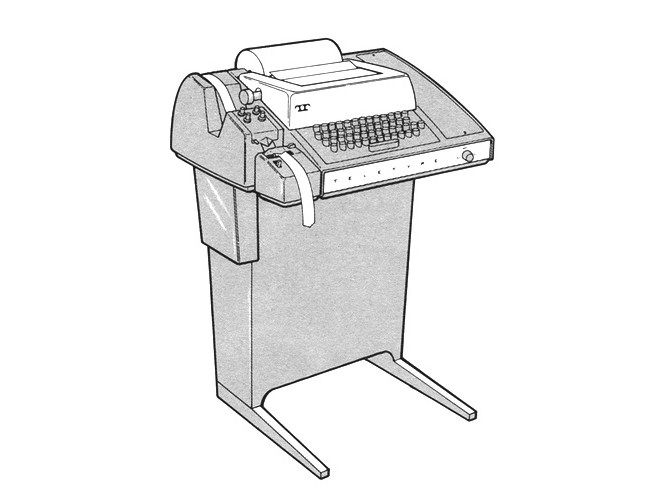 Teletype Corporation
Teletype Corporation
Popular minicomputers of the late 1960s and early '70s, such as the PDP-8, PDP-11, and the Data General Nova, supported ASCII encoding, making the Model 33 an ideal low-cost (relatively speaking) input/output (I/O) terminal for them. In particular, the PDP series by DEC were influential machines, and if you look up historical photos of them, you’ll almost always see a Teletype Model 33 in use beside them.
在 1960 年代末和 1970 年代初,流行的迷你计算机如 PDP-8、PDP-11 和 Data General Nova 都支持 ASCII 编码,这使得 Model 33 成为它们理想的低成本(相对而言)输入 / 输出(I/O)终端。特别是,由 DEC 推出的 PDP 系列 是具有影响力的机器,如果你查看它们的历史照片,你几乎总会看到旁边有一台 Teletype Model 33 正在使用。
When you used a teletype with a mainframe computer like these, you’d see your own local input on paper as you typed, and then you’d receive a response from the computer printed below it as the teletype printed to a continuous feed of rolled paper stored within the unit.
当你使用电传打字机与这样的主机计算机进行交互时,你输入的内容会在纸上显示出来,而接着你会看到计算机的响应打印在其下方,因为电传打字机会将输出打印到储存在设备内的连续纸卷上。
In 1970, Dennis Ritchie and Ken Thompson developed the UNIX operating system on a PDP-11 using Model 33 teletypes as interfaces, and some of the teletype-related design choices that they made are still with us today. The terms “TTY” on Linux, the Terminal app on Macs, and even, to some extent, the command prompt in Windows 10, all share a lineage with the line-by-line text output that originated on computers with teletype outputs.
在 1970 年,丹尼斯・里奇和肯・汤普森在 PDP-11 上开发了 UNIX 操作系统,并使用 Model 33 电传打字机作为接口,他们所做的一些与电传打字机相关的设计选择至今仍然存在 (依然影响着我们)。Linux 上的 “TTY”、Mac 上的终端应用程序,甚至在某种程度上,Windows 10 中的命令提示符都与源自电传打字机输出的逐行文本输出有着共同的渊源。
The Era of Teletype Games 电传打字游戏时代
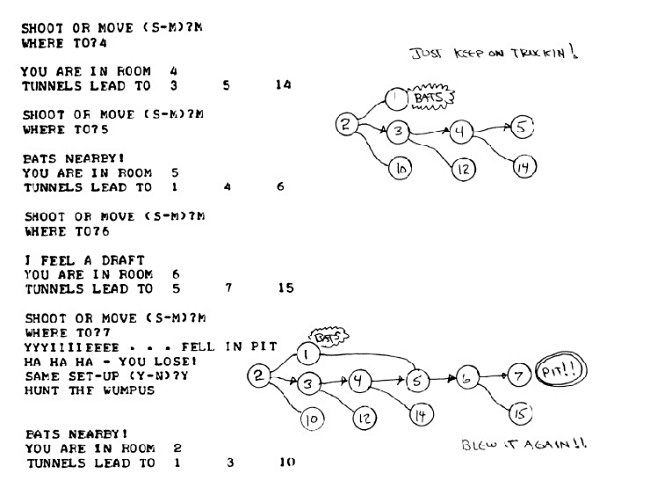 Creative Computing
Creative Computing
It’s worth noting that the teletype era produced a number of classic text-only games that went on to influence the video and computer game industries. Notable examples include Zork, Lunar Lander, Hunt the Wumpus, Star Trek, and The Oregon Trail. All these were originally played as text-only games with typed-in messages and output printed on teletype paper.
值得注意的是,电传打字机时代产生了一些经典的纯文本游戏,这些游戏对视频和计算机游戏行业产生了影响。著名的例子包括《Zork》、《Lunar Lander》、《Hunt the Wumpus》、《Star Trek》和《The Oregon Trail》。所有这些最初都是作为纯文本游戏进行玩的,通过键入消息并将输出打印在电传打字机纸上。
Why Did People Stop Using Teletypes with Computers? 为什么人们停止在计算机上使用电传打字机?
While popular for a time, Teletypes did have some significant drawbacks as computer terminals. They were very noisy due to the mechanical action of the impact printhead rapidly hitting the paper. They were also slow, often limited to about 10 characters per second. And finally, you had to use a lot of paper.
虽然电传打字机一度流行,但作为计算机终端确实有一些明显的缺点。由于冲击打印头的机械作用迅速撞击纸张,它们非常嘈杂。它们也很慢,通常限制在每秒 10 个字符左右。最后,你必须使用大量的纸张。
In the 1960s, companies such as IBM began experimenting with computer terminals that used CRT displays instead of paper for output. These early “glass teletypes” sought to provide faster interaction speeds and save money on paper waste. Still, many computer operators often stuck with teletypes throughout the 1970s due to their lower cost.
在 1960 年代,IBM 等公司开始试验使用 CRT 显示器而不是纸张进行输出的计算机终端。这些早期的 “玻璃电传打字机” 旨在提供更快的交互速度并节省纸张浪费。尽管如此,由于成本较低,许多计算机操作员在整个 1970 年代经常坚持使用电传打字机。
While at least three manufacturers produced video terminals by 1970, each cost significantly more than a Teletype Model 33. In 1974, Hewlett-Packard sold a rebranded version of the pioneering Datapoint 3300 video terminal called the HP2600A for $4,250. Around that same time, a Teletype Model 33 cost about $755 to $1,220 depending on which options were installed, representing significant savings. But the price of video terminals dropped dramatically in the 1970s, going down to about $800 per unit by 1980 depending on capability. (Around that time, the well-respected DEC VT-100 terminal typically sold for about $1,550).
到 1970 年时,至少有三家制造商生产视频终端,但每台的价格都比 Teletype Model 33 贵得多。在 1974 年,惠普出售了一款重新品牌化的开创性 Datapoint 3300 视频终端,名为 HP2600A,售价为 4250 美元。大约在同一时期,Teletype Model 33 的价格在 755 到 1220 美元之间,具体取决于安装了哪些选项,这代表了显著的节省。但是,视频终端的价格在 1970 年代急剧下降,到 1980 年,每台的价格降到了约 800 美元,具体取决于功能。(在那个时候,备受推崇的 DEC VT-100 终端通常售价约为 1550 美元)。
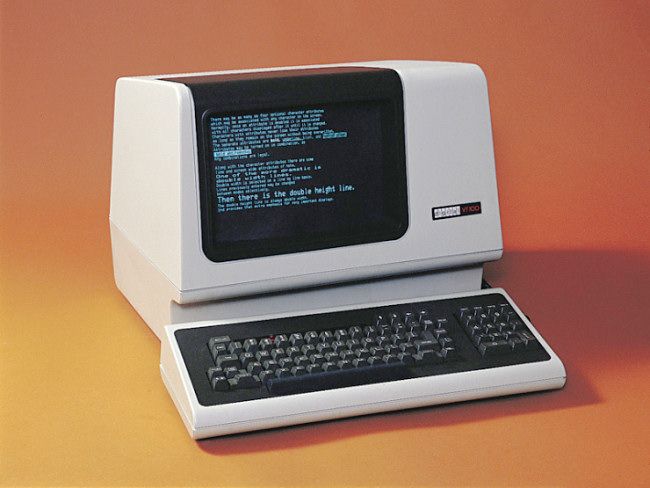 Video terminals like the DEC VT-100 (1978) made teletypes obsolete as computer terminals.
Video terminals like the DEC VT-100 (1978) made teletypes obsolete as computer terminals.
Once video terminals dropped in price and exceeded the capabilities of teletypes, teletypes quickly fell out of favor. Compared to teletypes, video terminals were silent and had no moving parts other than the keyboard, making them more reliable and pleasant to use. Their display speed also wasn’t limited to the mechanical action of a printhead, so they could display more information much faster than a teletype could.
一旦视频终端的价格下降并超越了电传打字机的性能,电传打字机很快就失去了受欢迎度。与电传打字机相比,视频终端是安静的,除了键盘之外没有任何活动部件,使得它们更加可靠和易于使用。它们的显示速度也不再受到打印头机械动作的限制,因此能够比电传打字机更快地显示更多信息。
Also, in the mid-1970s, personal computers like the Apple II began to integrate input and output functionality directly into the computer itself. In the case of the Apple II, owners could use a composite video security monitor or a standard TV set (with an RF modulator) as a display device, making any kind of external terminal—teletype or otherwise—unnecessary.
此外,在 1970 年代中期,个人计算机如 Apple II 开始将输入和输出功能直接集成到计算机本身。在 Apple II 的情况下,用户可以使用复合视频安全监视器或标准电视机(配备 RF 调制解调器)作为显示设备,这使得任何类型的外部终端 —— 无论是电传打字机还是其他设备 —— 都变得不必要。
So the next time that you sit down at your PC with a high-speed, high-resolution, bitmapped display that’s completely silent and sips power, be grateful that you don’t have to read How-To Geek through a printed feed machine-gunning away at 10 characters per second. But then again, it might actually be fun.
所以下次当你坐在高速度、高分辨率、静音且节能的位图显示器前时,要庆幸自己不必通过一台每秒只能打印 10 个字符的打印稿来阅读 How-To Geek。不过,话说回来,这或许也会挺有趣的。
via:
- What Are Teletypes, and Why Were They Used with Computers ? By Benj Edwards Published May 17, 2021
























 1307
1307

 被折叠的 条评论
为什么被折叠?
被折叠的 条评论
为什么被折叠?








